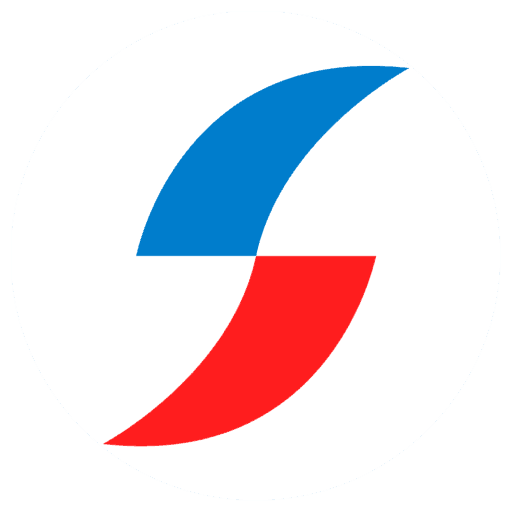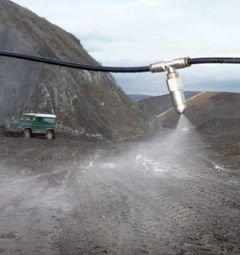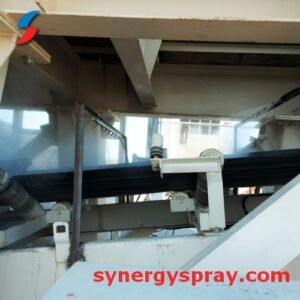FAQ & RESOURCES
How do I size a high-pressure misting pump for dust suppression?
Flow: sum all nozzle flow rates (L/min) × 1.10–1.20 safety factor.
Pressure: P_required = P_nozzle + pipeline losses + 10–15 bar margin.
Example: 60 nozzles × 0.15 L/min = 9.0 L/min → with 15% margin = 10.35 L/min. If nozzles need 70 bar and line loss ≈ 5 bar, select a pump ≈ 85 bar @ 10.5 L/min.
What droplet size should I target for different dust?
• Respirable silica/ore fines (PM2.5–10): ~10–50 µm (dry fog 1–10 µm when oversaturation must be avoided).
• Coal, limestone, aggregates: 30–200 µm (HP mist or fine cone).
• Wood/organic dust: 50–300 µm (overspray-tolerant).
Rule of thumb: match droplet same order of magnitude as dust; too large → slipstreaming, too small → drift.
How many nozzles do I need at a conveyor transfer point?
• Cover 1.2× belt width across the plume.
• Spacing: 0.8–1.2 m between nozzles on a header; aim 30–45° into the plume.
• Treat 3 zones: loading chute, mid-transfer, discharge skirt. Interlock with belt-run & chute level sensors.
What’s the design approach for dump hoppers & stockpiles?
• Dump hoppers: ring manifold (two rows), opposing fine-cone nozzles to form a fog curtain; photocell trigger.
• Stockpiles: oscillating cannons (throw 30–100 m), program sweep angles vs. wind; add edge mist rings at reclaim points.
What water quality/filtration do high-pressure systems require?
• Filtration train: 20 µm → 5 µm → 1 µm (final).
• Scaling control: softening/anti-scale; use RO where hardness is high to protect 50–80 bar pumps and micro-orifices.
• Keep free chlorine low for stainless longevity; use SS316 in corrosive atmospheres.
Will the system wet my product? How do I prevent it?
• Use dry fog (1–10 µm) or very low flow HP mist, short duty cycles, VFD pump control.
• Add surfactants only when needed and at low dose.
• Place nozzles above plume with cross-fire, not directly onto product.
How do I estimate energy & water consumption?
• Water (L/h) = total L/min × 60 × duty cycle.
• Motor kW ≈ (Q[L/min] × P[bar]) / (600 × η).
Example: 10.35 L/min @ 85 bar, η=0.8 → ~1.83 kW, water ~621 L/h at 100% duty.
What automation improves efficiency?
• Sensors: PM monitors, humidity, belt-run, chute level, wind.
• Controls: PLC/SCADA, VFD on HP pump, zone valves, time-proportioned pulsing.
• Interlocks: conveyor trip → instant spray cutoff; wind-based cannon slew/flow.
Which materials, enclosures, and ratings should I specify?
• Wetted parts: SS316 for corrosive/chemical; SS304 for general.
• Enclosures: IP65+ for outdoors; UV-stable hoses.
• Hazardous areas: specify ATEX/IECEx or equivalent for dust Zones 21/22; TEFC/Ex motors as required.
Dry fog vs. High Pressure mist vs. sprinklers vs. cannons — when to use?
• Dry fog (1–10 µm): minimal wetting; chutes/transfer points; needs clean dry air and fine filtration.
• HP mist (10–50 µm): general industrial, flexible zoning, low water use.
• Sprinklers (100–1000 µm): yard dust & roadways; high water, low finesse.
• Cannons: long-range open areas, stockyards; add wind logic to cut drift.
What’s a practical maintenance schedule?
• Weekly: check filters, strainers, leaks, nozzle pattern; drain separators.
• Monthly: flush headers/lines; inspect belts/couplings; clean nozzle tips.
• Quarterly: service pump (oil/seals per OEM), calibrate sensors; verify relief valve & gauges.
How do I document compliance & effectiveness?
Baseline PM2.5/PM10 readings, capture before/after at fixed locations, log duty cycles/flow, keep SOPs, HIRA/JSA, and maintenance records aligned to local standards (e.g., CPCB/OSHA guidance).
What data should my RFQ include for accurate sizing?
Dust source & process, throughput (TPH), particle characteristics, belt width/speed, indoor/outdoor, target reduction, available power/water/air, water analysis, ambient temperature/RH/wind, control integration (PLC/SCADA), hazard classification, corrosion class, and preferred materials.
Can I run dry-fog on existing compressed air?
Yes—provide clean, dry air (CDA) with adequate flow, stable pressure, filtration to oil/water-free, and a dew point below the lowest ambient to prevent icing.
How do I retrofit on running conveyors with minimal downtime?
Use clamp-on manifolds, flexible high-pressure hoses, quick-disconnects, skid-mounted pump/filter sets, pre-wired control panels; commission zone-by-zone during planned micro-stoppages.










